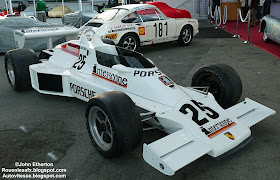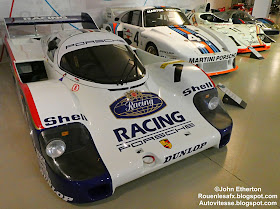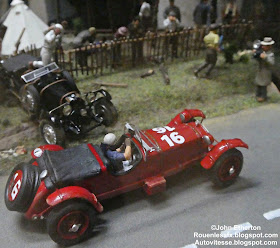 |
| Patrick Long demonstrating a 1990 March-Porsche Indy Car at Rennsport Reunion VI. |
Porsche is well known for racing its GT cars and sports racing cars. Sometimes we are apt to forget its forays into single seater racing. Thus, I was pleased to see a few reminders at the Porsche Rennsport Reunion VI.
FORMULA TWO
Since its beginnings in 1948 Porsche had had success with small capacity Sports and GT racers. This had culminated in an overall victory in the 1956 Targa Florio with a 1.5 litre 550 RS Spyder driven by Umberto Maglioli. Then in 1957 the regulations for Formula Two changed to a maximum capacity of 1,500cc and it was announced that this would become the new Formula One from 1961. Porsche produced a centre steer 718 RSK with all-enveloping bodywork for both sports car racing and F2. Jean Behra shocked the World by winning in the car in a F2 race at Reims in 1958. Masten Gregory repeated the triumph in a F2 race at the banked Avus later in the year. Elsewhere, the heavy body disadvantaged the car but on fast circuits the streamlined body was an advantage.
 |
| Centre steer Porsche 718 RSK at Laguna Seca. |
For 1959 Porsche produced a proper open wheel 718 F2 car and this had some success over the next few years. Notable was a 1-2-3 victory in the 1960 Aintree 200 for Moss, Bonnier and Hill, a 1-2 in the German GP on the Sudschliefe for Bonnier and Von Trips, a 1-2-3 at Zeltweg for Moss, Herrmann and Barth, and a win for Bonnier at Modena beating the Ferraris on home-turf.
FORMULA ONE
In 1961 a new 1.5 litre era of Formula one commenced. Apart from Ferrari nobody was particularly ready. Porsche had its rather bulbous 718 F2 car chassis and its 160 bhp 4 cylinder engine but its attempt to produce a more powerful flat eight failed. However, this proved relatively competitive except against the Ferraris.Bonnier won a heat at the Brussels GP, Gurney came second at Syracuse, and Bonnier came second at Solitude, Karlskoga and Modena. In the World Championship races, Gurney came second in France, Italy and the USA to finish fourth in the drivers championship. Porsche finished third in the constructors championship.
 |
| The Porsche 804 F1 car on display at Laguna Seca. |
For 1962 Porsche produced a new sleek 804 F1 car with a 180bhp air cooled flat eight engine. After retiring from the first two grand prix of the season, Dan Gurney won the French GP at Rouen through reliability. This remains Porsche's only World Championship GP victory for chassis and engine. Dan Gurney took pole position for the German GP at the Nurburgring but could only finish third. In a non-championship race at the Solitude circuit, near Porsche's home town of Stuttgart, Dan Gurney led Jo Bonnier to a 1-2 victory. Carel Godin de Beaufort finished fifth in a 718 which he continued to campaign in F1 until killed at the 1964 German GP. At the end of 1962 Porsche concluded its F2 programme due to reasons of high cost compared to results and went back to its roots of Sports Car racing.
 |
| The 1962 Solitude GP winning car. |
 |
| Porsche 804 F1. |
INDY CAR
Having produced a successful turbocharged engine for Sports Car racing in the seventies, it was perhaps no surprise that Indy Car was a temptation for Porsche in 1980. The plan was to cooperate with Ted Field's Interscope team. They provided a modified Parnelli VPJ6B Indy Car chassis and Porsche provided a Type 935/72 turbo charged flat 6 engine developed by Valentin Schaffer. Interscope clocked up a lot of testing miles and Danny Ongais would have been the driver. This was a time of conflict in Indy Car racing between CART and USAC. Eventually Porsche withdrew because of a ruling that it would have to run the same boost level as the Cosworth DVX V8. Thus the project was still born.
 |
| Stillborn Interscope - Porsche Indy Car project from 1980. |
 |
| The first Porsche indy Car project. |
PIKES PEAK
Porsche has been associated with many hillclimb special over the years. In 1981 one of these nearly won the Pike's Peak International Hillclimb - probably the most prestigious hillclimb in the World. Bruce Canepa was originally a dirt track racer and in 1981 decided to tackle Pike's Peak in a single seater open wheel type racer powered by a twin turbo Porsche 911 engine. He qualified first and eventually finished second after a spin to avoid a spectator who was crossing the track.
 |
| The Caneopa Nearman-Dreager Porsche special that came second at Pike's Peak in 1981. |
RETURN TO FORMULA ONE AS AN ENGINE PROVIDER
The nineteen eighties was the era of the dominance of turbo charged engines in Formula One. As a successful producer of turbo charged engines for Sports Cars, it is not that surprising that McLaren approached Porsche to provide a turbo-charged F1 engine. The project was funded by TAG a Saudi Investment company. Thus Porsche designed and developed the twin turbocharged V6 1,449 cc TAG-TTE P01. It made its debut in the Dutch GP of 1983 bolted on to a McLaren MP4/1E in the capable hands of Niki Lauda but retired. By the end of the year the car had started to become competitive with Lauda running second in the South African GP. For 1984 and 1985 the Porsche engine would produce more power and was installed in the carbon fibre MP4/2. This was a potent combination and in addition the drivers were old hand Niki Lauda and a promising new talent in Alain Prost. Together they won twelve Championship races and Lauda pipped Prost to the championship by half a point. McLaren-TAG were constructors champions with the Porsche developed engine. In 1985 they won the Constructors Championship again but this time Alain Prost took the drivers championship. In 1986 Prost again won the championship but Williams-Honda had become the dominant car and won the constructors championship.
 |
| Prost's championship winning 1985 McLaren-TAG MP4/2b car. |
 |
| A reminder of Porsche's eighties F1 success at Laguna Seca. |
INDY CAR PROJECT PART TWO
Following their F1 success with McLaren-TAG, Porsche decided to return to Indy. Thus a Porsche 2708 Chassis and 2708/80 engine were built for an assault on the 1988 Indy 500. This time Porsche under the guidance of Hans Mezger chose a V8 engine. The car made its debut at Laguna Seca in 1987 in the hands of Al Unser Snr but the debut was not a success. Al Holbert failed to qualify for the final race of the season so in 1988 the Porsche chassis was dumped in favour of one from March. The March-Porsche raced in Indy Car from 1988 to 1990. In 1988 Teo Fabi finished tenth in the championship, but in 1989 this had improved to fourth place in the championship. The highlight was a win at Mid Ohio. For 1990 a two car team was entered by Porsche North America with Teo Fabi (No.4) and John Andretti (No.41) as the drivers. This season was not as successful as in 1989 and John Andretti finished tenth in the championship and Teo Fabi fourteenth. Best finish was a third place at Meadowlands for Teo Fabi. Both cars from the 1990 season were at Laguna Seca.
 |
| Two 1990 March-Porsche Indy Cars |
 |
| Teo Fabi's 1990 Porsche Indy Car. |
John Etherton asserts his copyright to all of the photos on this blogpost. However, you may post the photos elsewhere on the web as long as you credit the photographer, John Etherton, and this blog post, Rouenlesafx@blogspot.com and provide a link to this page.
John Etherton affirme son droit d'auteur à l'ensemble des photos sur ce billet de blog. Cependant, vous pouvez poster des photos ailleurs sur le web aussi longtemps que vous créditez le photographe, John Etherton, et ce blog, Rouenlesafx@blogspot.com et fournissez un lien vers cette page.
Perhaps Porsche's least well known single seater programme is the one shown below! They produced tractors from 1956 to 1963.
 |
| Jeff Zwart in his tractor driving through the paddock to the Porsche Tractor race on Saturday at Laguna Seca. |































































